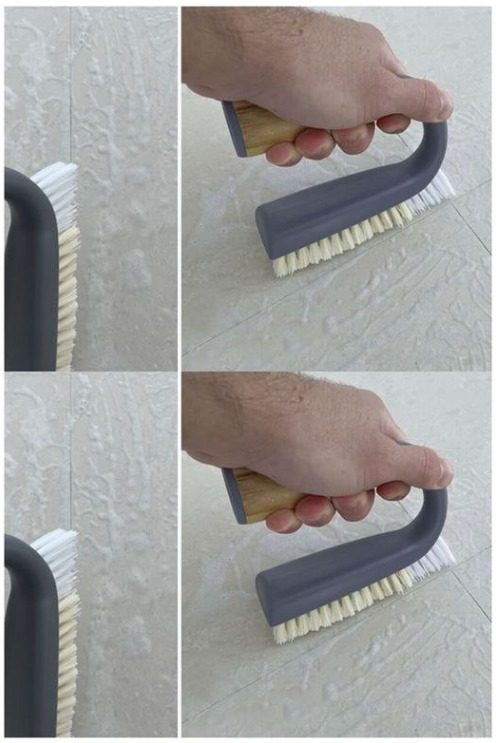ADVERTISEMENT
Step-by-Step Instructions:
- Create a Grout Cleaning Paste: In a small bowl, mix together equal parts of baking soda and hydrogen peroxide. For extra cleaning power, you can add a squirt of dish soap to the mixture. The baking soda acts as a gentle abrasive to scrub away dirt and stains, while hydrogen peroxide is a natural bleach that helps to whiten and disinfect the grout. The dish soap helps to break down oils and grime. Stir the mixture until you have a thick paste. If the paste is too thick, add a little more hydrogen peroxide until it reaches a spreadable consistency.
- Apply the Paste to the Grout: Using your fingers or an old toothbrush, apply the paste directly to the stained grout lines. Make sure the grout is fully coated with the paste, focusing on areas with the most discoloration. Don’t worry if the paste looks thick; it’s doing the hard work of breaking down the grime.
- Let the Paste Sit: Allow the paste to sit on the grout for 10 to 15 minutes. During this time, the baking soda and hydrogen peroxide will work together to lift the stains and whiten the grout.
- Scrub the Grout: After the paste has had time to sit, take an old toothbrush or grout brush and scrub the grout lines in a circular motion. This step is essential for loosening the dirt and grime that has built up over time. Be gentle but thorough – you don’t need to scrub aggressively, as the paste should already have softened the stains. For stubborn spots, you can apply a little extra paste and give those areas a more focused scrub.
- Rinse and Wipe Away the Paste: Once you’ve scrubbed the grout, rinse the area with warm water to remove the paste. You can use a damp cloth or sponge to wipe the grout clean, making sure to remove any residue. If necessary, you can repeat the process in areas that still have visible stains.
- Dry the Grout: After rinsing and cleaning, use a dry towel or cloth to gently pat the grout dry. This helps prevent water from soaking back into the grout, which could potentially cause more staining or mold growth.
- Optional – Seal the Grout: Once your grout is clean and dry, consider applying a grout sealer to keep it looking fresh for longer. The sealer creates a protective barrier that prevents dirt and moisture from penetrating the grout. This step is especially helpful for high-traffic areas and bathrooms where moisture is prevalent.
Additional Tips for Maintaining Clean Grout:
- Regular Cleaning: For ongoing maintenance, try wiping down grout lines with a mild cleaner or vinegar solution once a week. Regular cleaning prevents dirt and stains from building up over time.
- Avoid Harsh Chemicals: While bleach and other harsh chemicals can be effective at whitening grout, they can also damage the grout and surrounding tiles if used too often. Stick to natural solutions like baking soda and hydrogen peroxide for regular cleaning.
- Use a Steam Cleaner: For a deep clean, a steam cleaner can be a great tool to sanitize grout lines without the need for chemical cleaning products. It’s especially useful for removing mold or mildew from grout.
- Dry Surfaces After Use: In areas like bathrooms, be sure to dry grout after showers or baths to reduce the risk of mold and mildew. A quick towel down can help preserve the whiteness of your grout.
Why This Method Works:
- Natural Ingredients: The combination of baking soda and hydrogen peroxide is a powerhouse when it comes to cleaning grout. Baking soda is mildly abrasive, which helps scrub away surface dirt without damaging the grout, while hydrogen peroxide lifts stains and has natural whitening properties.
- No Harsh Chemicals: Unlike commercial grout cleaners that can be full of harmful chemicals, this method uses safe and natural ingredients found in most households. It’s an eco-friendly and budget-friendly option for cleaning grout.
- Cost-Effective: Instead of spending money on expensive grout cleaners or hiring a professional, you can achieve excellent results with just a few inexpensive ingredients.
Conclusion:
Grout can easily become discolored and grimy, but with the right cleaning method, you can restore it to a like-new condition. The combination of baking soda, hydrogen peroxide, and a little scrubbing will effectively lift stains and whiten grout without harsh chemicals. Not only is this method simple and cost-effective, but it’s also safe for your tiles and the environment.
So, if you’re tired of looking at dull, dirty grout, give this method a try! In no time, your grout will look as fresh and clean as the day it was installed, bringing new life to your floors and walls.
ADVERTISEMENT
